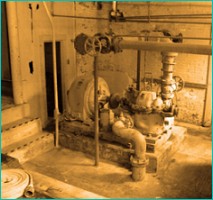|
BEL TV "Somewhere in Waldo County" Belfast Water October 2016 Interview with Ned Lightner
https://vimeo.com/album/240225/video/191581236
* * * * * * * * * * * * * * * * * * * * * * * * *
DEDICATION OF THE LITTLE RIVER OFFICE BUILDING
http://waldo.villagesoup.com/p/1660576#.WUCIaZuSLKs.email
* * * * * * * * * * * * * * * * * * * * * * * * *
A Brief History of the Belfast Water District
1887 to Present
Compiled by Nancy L. Smith (2003)
The
need for a water supply for fire protection following the devastating fires,
which swept through downtown Belfast in 1865 and again in 1873, prompted the
City to purchase Kirby Lake, which we know today as the Muck. After a period of
10 years, determining the water supply was no longer adequate for fire
protection for Belfast businesses, Belfast voters, in a special election,
decided overwhelmingly to accept a proposal of Parks & Wheeler, civil engineers
from Boston, Massachusetts, to create a water company, and in 1887, the Belfast
Water Company was formed.
Construction began at Little River, with the creation of a 175-foot long dam
near the mouth of the Little River, on a 55-acre reservoir, with an average
depth of 20 feet. A handsome brick pump house at Little River, constructed along
the north side of the dam, having two turbine pumps, and an auxiliary steam
pump, quickly became a landmark. The water company generated its own power at
the dam, utilizing the steam pump when the flow of water diminished, usually a
period of two months during the summer. The pump house was modified during World
War II with the addition of a lookout cupola used by Civilian Defense for a
clear view of the bay in search of enemy submarines. Construction of the
distribution system began with a main, which ran from Little River to a
standpipe, having a capacity of 263,000 gallons, constructed on Wilson’s Hill,
the highest point in the city, three miles from Little River. A neighbor living
on Wilson’s Hill was given his water free for informing the Water Company when
the Standpipe was full to overflowing. Cast iron mains were laid from the
standpipe to the intersection of Main and High Streets. The trenches for these
mains were all dug by hand, with great difficulty, using shovels and pick axes
through the layers of ledge.
There were 40 hydrants located in the primary streets of the downtown for fire
protection, and in 1888, 4 water fountains were erected on the corners of
Church, Main and High Streets for man and beast, to the delight of the
townspeople. Operating costs of the water plant and distribution system, as it
remains today, were met by the collection of revenue from its customers.
By 1891 there were 50 operating fire hydrants, for which the city of Belfast
paid $1,800.00 per year, and 317 private and manufacturing water services
ranging from $6.00 to $500.00 per year.
In 1918 City officials approached Parks & Wheeler about purchasing the water
company, to which they agreed. In 1919, by legislative charter, the state
created and incorporated, the Belfast Water District, a quasi-municipal,
non-profit entity, separate from the City, supported by consumer revenue, whose
board of Trustees would be appointed by the Belfast City Council. At their first
meeting on October 25, 1919, the new three person Board of Trustees voted to
purchase from the Belfast Water Company the entire water plant, all properties,
franchises, equipment, rights and privileges.
By 1927, the Belfast Water District supplied a population of about 5,000, with
12 ¾ miles of water mains. With the acquisition of water shed properties around
the upper and lower reservoirs, thus reducing the runoff from animal pastures
and cultivated lands, and the addition of the purification plant, the quality of
the water greatly improved.
Following two days of steady rain, on Sunday October 17, 1943, both upper and
lower reservoirs already at flood stage, another cloud burst with an additional
4 ½ inches of rain fell (the heaviest rainfall ever recorded in 65 years). The
water rose to 5 ½ feet over the spillway forcing ten-foot granite blocks to fall
off the south face of the dam. The weakened dam finally breeched and the
combination of the enormous force of water propelling granite blocks in the
direction of the bridge on Route 1, and a wall of water rushing in from the bay
on a wild incoming tide, took out the already weakened bridge. All of Waldo
County was experiencing flooding of streets and residences from the torrential
rainfall. The pump house was also flooded and windows and doors blown out.
Photo
Help from the Augusta Water District and the Camden Fire Department by setting
up temporary pumping capacity at Kirby Lake, resulted in uninterrupted water
service to the people of Belfast. The dam was replaced in 1944 at a cost of
$50,000.00. An erosion protection project was completed by the Army Corps of
Engineers in 1988 at a cost of $150,000.00.
In the 1950s two wells were drilled into a sand and gravel aquifer on the east
side of Belfast for additional water supply and in 1980, when the Water District
discontinued using the Little River reservoirs, these wells became the sole
supply of pure, high quality water for the district’s 1,800+ customers.
Today, in addition to the two eastside wells, there are four above ground
storage tanks with a 3-day water supply, and 39 miles of water mains supplying a
population of 6,750. There are back up generators at each well site and security
measures in place at all districts wells, pump stations and water district
facilities. Since amending the Charter in 1973, the number of Trustees has
increased from three to five, one of whom is appointed each year.
Throughout its 116 year history the Belfast Water District has benefited from
the dedication to service and the uncompromising work ethic of its trustees and
superintendents. Under their leadership and management the water utility is
today regarded as an efficiently operated, quality water service, recognized by
the State of Maine for its superior quality of pure water, its value and
protection of its water resources and its service to the community.
Listed below are the names of the past and current superintendents to whom we
owe a debt of gratitude.
| 1887-1919 |
W. A. Parks |
| 1919-1925 |
D. N. Bird |
| 1925 |
J. B. Longley |
| 1926-1950 |
Aubrey L. Ramsdell |
| 1950-1956 |
Horace E. Blanchard |
| 1956 - 1979 |
Roy C. Talbot |
| 1979 - 1985 |
Milford E. Rhodes |
| 1985 - 2005 |
Harry T. Smith |
| 2005 - 2023 |
Keith H. Pooler |
| 2023 - Current |
Frank D. Short |
The “modernization” of the Belfast Water District has been interesting and
challenging over the years. The handsome brick pump house, welcomes travelers
and visitors, as a sentinel of the southernmost point of the City and is a mecca
for photographers. The common link between the old and the new is the value
placed on the water resources and the dedication to service of those who worked
for the District in the past to the crew who serves today. The Belfast Water
District is a unique and special blend of history and modern utility services
and its crew has earned the pride they feel in the job they do and the
appreciation of those they serve.

|


